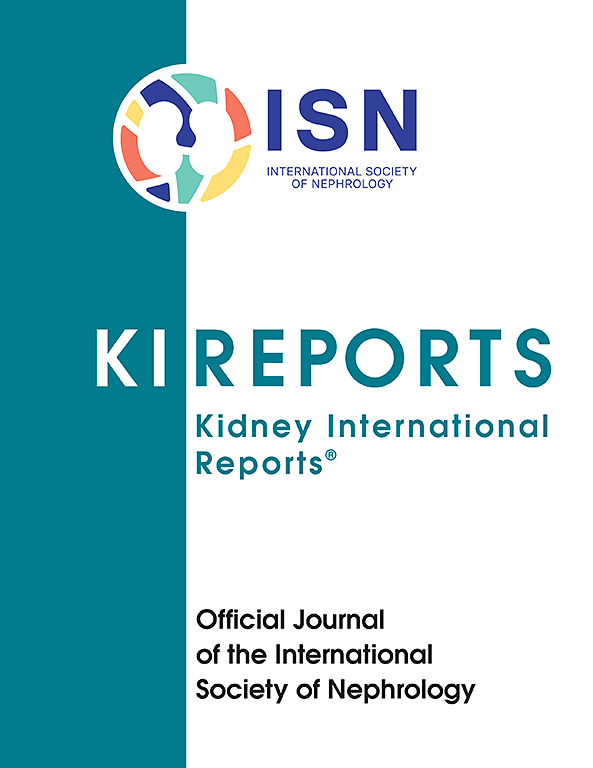The Retinal Vasculature and Risk of Age-Related GFR Decline — The Renal Iohexol Clearance Survey
IF 5.7
2区 医学
Q1 UROLOGY & NEPHROLOGY
引用次数: 0
Abstract
Introduction
Age-related decline in glomerular filtration rate (GFR) significantly contributes to chronic kidney disease (CKD). This longitudinal study in a nondiabetic population investigated whether retinal microvascular changes are associated with GFR decline.
Methods
The Renal Iohexol Clearance Survey (RENIS) included 1837 participants aged 50 to 62 years without self-reported diabetes, kidney or cardiovascular disease. Baseline retinal vessel measurements and retinopathy were assessed with a Visucam PRONM retinal camera. Iohexol clearance was measured over 1 to 4 visits across an 11-year median follow-up. Linear mixed models and logistic regression were used to analyze associations between retinal vessel measurements, retinopathy, mean annual GFR decline, and accelerated GFR decline.
Results
In multiple adjusted linear mixed models, wider central retinal venular equivalent (CRVE) and wider central retinal arteriolar equivalent (CRAE) were associated with a steeper mean measured GFR (mGFR) decline. For each SD increase, CRVE was associated with an mGFR decline of −0.08 ml/min/yr (95% confidence interval [CI]:−0.15 to −0.02; P = 0.012), and CRAE was associated with a decline of −0.09 ml/min/yr (95% CI:−0.15 to −0.02; P = 0.007). CRVE, but not CRAE, was associated with accelerated mGFR decline in the model adjusted for age, sex, and height [OR 1.31 (95% CI 1.07-1.61, P = 0.008]. No significant associations were observed between retinopathy, microaneurysms, and hemorrhages with annual or accelerated mGFR decline.
Conclusion
CRVE and CRAE, but not retinopathy, retinal microaneurysms, or hemorrhages, were associated with steeper mean mGFR, suggesting that microvascular changes may be one of the underlying mechanisms for age-related GFR loss in a general nondiabetic population.

视网膜血管和年龄相关性GFR下降的风险——肾碘己醇清除率调查
年龄相关性肾小球滤过率(GFR)下降对慢性肾脏疾病(CKD)有显著影响。这项在非糖尿病人群中进行的纵向研究调查了视网膜微血管改变是否与GFR下降有关。方法肾碘己醇清除率调查(RENIS)纳入1837名年龄在50至62岁之间、无自述糖尿病、肾脏或心血管疾病的参与者。使用Visucam PRONM视网膜相机评估基线视网膜血管测量和视网膜病变。在11年的中位随访中,通过1- 4次访视来测量碘hexol清除率。使用线性混合模型和逻辑回归分析视网膜血管测量、视网膜病变、GFR平均年下降和GFR加速下降之间的关系。结果在多重调整线性混合模型中,更宽的视网膜中央静脉当量(CRVE)和更宽的视网膜中央动脉当量(CRAE)与更陡的平均测量GFR (mGFR)下降相关。每增加一个SD, CRVE与mGFR下降- 0.08 ml/min/yr相关(95%置信区间[CI]: - 0.15至- 0.02;P = 0.012), CRAE与- 0.09 ml/min/yr的下降相关(95% CI: - 0.15至- 0.02;P = 0.007)。在经年龄、性别和身高调整后的模型中,CRVE与mGFR加速下降相关,而CRAE与此无关[OR 1.31 (95% CI 1.07-1.61, P = 0.008]。视网膜病变、微动脉瘤和出血与mGFR年度或加速下降之间没有显著关联。结论:crve和CRAE,而非视网膜病变、视网膜微动脉瘤或出血,与更陡峭的平均mGFR相关,提示微血管变化可能是一般非糖尿病人群中年龄相关性GFR下降的潜在机制之一。
本文章由计算机程序翻译,如有差异,请以英文原文为准。
求助全文
约1分钟内获得全文
求助全文
来源期刊

Kidney International Reports
Medicine-Nephrology
CiteScore
7.70
自引率
3.30%
发文量
1578
审稿时长
8 weeks
期刊介绍:
Kidney International Reports, an official journal of the International Society of Nephrology, is a peer-reviewed, open access journal devoted to the publication of leading research and developments related to kidney disease. With the primary aim of contributing to improved care of patients with kidney disease, the journal will publish original clinical and select translational articles and educational content related to the pathogenesis, evaluation and management of acute and chronic kidney disease, end stage renal disease (including transplantation), acid-base, fluid and electrolyte disturbances and hypertension. Of particular interest are submissions related to clinical trials, epidemiology, systematic reviews (including meta-analyses) and outcomes research. The journal will also provide a platform for wider dissemination of national and regional guidelines as well as consensus meeting reports.
 求助内容:
求助内容: 应助结果提醒方式:
应助结果提醒方式:


